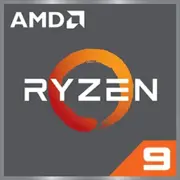AMD Ryzen 9 8945HS

AMD Ryzen 9 8945HS: Power and Efficiency in a Slim Package
Introduction
AMD's Ryzen 9 series laptop processors have always attracted attention for their combination of high performance and energy efficiency. The Ryzen 9 8945HS (Hawk Point) model is a new flagship for ultrabooks and mobile workstations. With 8 cores, 16 threads, and a 4nm manufacturing process, this chip promises competition with the Intel Core i9 and Apple M3. Let's explore who this processor is suitable for, how it performs in real tasks, and what to keep in mind when choosing a laptop.
Architecture and Process: Zen 4 and RDNA 3 Under the Hood
Cores, Threads, and Frequencies
The Ryzen 9 8945HS is built on the Zen 4 architecture, which provides up to a 13% IPC (instructions per clock) increase compared to Zen 3. The configuration includes 8 cores and 16 threads with a base clock of 4 GHz and a turbo mode of up to 5.2 GHz. This range allows for energy savings during light tasks while delivering an instant boost under load.
Cache Memory: 16 MB of L3 cache reduces data processing latency, which is critical for gaming and professional applications.
Integrated Graphics Radeon 780M
The chip features an iGPU Radeon 780M based on the RDNA 3 architecture with 12 compute units. This is one of the most powerful integrated graphics systems on the market, capable of competing with entry-level discrete GPUs like the NVIDIA MX550. Support for technologies such as FSR and Ray Tracing makes it appealing to gamers.
Example: In Dota 2 at Ultra settings (1080p), the Radeon 780M delivers stable 60-70 FPS.
Power Consumption and TDP: A Balance Between Power and Longevity
TDP 15W: What Does It Mean?
The processor's nominal thermal design power (TDP) is 15W, but in turbo mode, power can temporarily reach 45-50W. This allows for sustained high performance in "thin" laptops like the ASUS ZenBook or Lenovo Yoga without overheating.
Power Management Features:
- Precision Boost 2: Dynamically adjusts core frequencies based on load and temperature.
- Adaptive Power Management: Optimizes energy consumption in background tasks, such as when working with a browser or office applications.
Performance: Tests in Real Scenarios
Office Work and Multitasking
In PCMark 10 tests, the Ryzen 9 8945HS scores 6800 points, which is 15% higher than the previous generation (Ryzen 9 7940HS). Working simultaneously with 20 Chrome tabs, Excel, and Zoom causes no slowdowns.
Multimedia and Rendering
- HandBrake (converting 4K to 1080p): 12 minutes vs. 14 minutes for the Intel Core i7-13700H.
- Blender (rendering the BMW model): 3 minutes 40 seconds — a result close to the desktop Ryzen 7 7700X.
Gaming: Integrated Graphics vs. Discrete
- Cyberpunk 2077 (1080p, Low, FSR Quality): 35-40 FPS.
- Forza Horizon 5 (1080p, Medium): 55-60 FPS.
For comfortable gaming in AAA titles, an external graphics card (e.g., RTX 4060) will be necessary, but the iGPU is sufficient for eSports titles.
Turbo Mode: How Long Does It Hold 5.2 GHz?
In a laptop with an effective cooling system (e.g., MSI Stealth 16), the processor maintains a frequency of 5 GHz for up to 10 minutes under load. In ultrabooks like the Dell XPS 13, turbo mode activates in short bursts (2-3 minutes) to avoid overheating.
Use Cases: Who Needs the Ryzen 9 8945HS
1. Professionals:
- Video editors working on Premiere Pro on the go.
- Developers compiling code in Visual Studio or Android Studio.
2. Gamers:
- Those who play Dota 2, CS2, or Fortnite without a discrete GPU.
3. General Users:
- Students balancing studies, entertainment, and light gaming.
Battery Life: How Long Will the Laptop Last?
With a battery capacity of 75 Wh:
- Office Tasks (brightness 50%): 8-10 hours.
- YouTube Watching: 6-7 hours.
- Gaming on iGPU: 1.5-2 hours.
Energy-Saving Technologies:
- Core Parking: Disables unused cores in the background.
- Dynamic Voltage and Frequency Scaling (DVFS): Reduces core voltage under low load.
Comparison with Competitors: AMD vs Intel vs Apple
AMD Ryzen 9 7940HS (Previous Generation)
- Multithreaded tasks increase by 10-12% due to optimizations in Zen 4.
- iGPU Radeon 780M is 15% faster than Radeon 760M.
Intel Core i9-13900H
- Higher single-core performance (Geekbench 6: 2900 vs 2627).
- Weaker multithreaded results (12500 vs 13045).
- TDP of 45W vs. 15W for AMD.
Apple M3 Pro
- Better energy efficiency (up to 18 hours of battery life).
- Weaker in gaming and applications not optimized for Apple Silicon.
Pros and Cons
Strengths:
- Best-in-class multithreaded performance.
- Powerful integrated graphics.
- Support for DDR5-5600 and PCIe 4.0.
Weaknesses:
- Throttling may occur in ultrabooks under prolonged load.
- Lack of Thunderbolt 4 support (only USB4).
Recommendations for Choosing a Laptop
1. Type of Device:
- Ultrabooks: ASUS ZenBook Pro 14, Lenovo Slim 7. Focus on portability.
- Gaming Laptops: MSI Delta 15. Discrete GPU is a must.
- Workstations: Dell Precision 5570. Requires 32+ GB of RAM.
2. What to Look For:
- Cooling: At least two fans and heat pipes.
- Display: For gaming — 144 Hz; for work — 4K OLED.
- Battery: At least 70 Wh for long battery life.
Final Conclusion
Ryzen 9 8945HS is an ideal choice for those who need a versatile laptop without compromises. This processor is for:
- Professionals who value mobility and rendering speed.
- Gamers ready to play at medium settings without an external GPU.
- Students looking for an all-in-one device.
Its key advantages are flagship performance in a compact form factor and revolutionary energy efficiency. If you want a powerful laptop that won't run out of battery in three hours and won't overheat in your backpack, the Ryzen 9 8945HS is worth considering first.
Basic
CPU Specifications
Memory Specifications
GPU Specifications
Benchmarks
Compared to Other CPU
Share in social media
Or Link To Us
<a href="https://cputronic.com/cpu/amd-ryzen-9-8945hs" target="_blank">AMD Ryzen 9 8945HS</a>